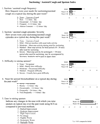Lower thoracic spinal cord stimulation to restore cough in patients with spinal cord injury: results of a National Institutes of Health-Sponsored clinical trial. Part II: clinical outcomes
- PMID: 19406290
- PMCID: PMC2809374
- DOI: 10.1016/j.apmr.2008.11.014
Lower thoracic spinal cord stimulation to restore cough in patients with spinal cord injury: results of a National Institutes of Health-Sponsored clinical trial. Part II: clinical outcomes
Abstract
Objective: To evaluate the clinical effects of spinal cord stimulation (SCS) to restore cough in subjects with cervical spinal cord injury.
Design: Clinical trial assessing the clinical outcomes and side effects associated with the cough system.
Setting: Outpatient hospital or residence.
Participants: Subjects (N=9; 8 men, 1 woman) with cervical spinal cord injury.
Interventions: SCS was performed at home by either the subjects themselves or caregivers on a chronic basis and as needed for secretion management.
Main outcome measures: Ease in raising secretions, requirement for trained caregiver support related to secretion management, and incidence of acute respiratory tract infections.
Results: The degree of difficulty in raising secretions improved markedly, and the need for alternative methods of secretion removal was virtually eliminated. Subject life quality related to respiratory care improved, with subjects reporting greater control of breathing problems and enhanced mobility. The incidence of acute respiratory tract infections fell from 2.0+/-0.5 to 0.7+/-0.4 events/subject year (P<.01), and mean level of trained caregiver support related to secretion management measured over a 2-week period decreased from 16.9+/-7.9 to 2.1+/-1.6 and 0.4+/-0.3 times/wk (P<.01) at 28 and 40 weeks after implantation of the device, respectively. Three subjects developed mild hemodynamic effects that abated completely with continued SCS. Subjects experienced mild leg jerks during SCS, which were well tolerated. There were no instances of bowel or bladder leakage.
Conclusions: Restoration of cough via SCS is safe and efficacious. This method improves life quality and has the potential to reduce the morbidity and mortality associated with recurrent respiratory tract infections in this patient population.
Trial registration: ClinicalTrials.gov NCT00116337.
Conflict of interest statement
Figures




References
-
- Loudon RG, Shaw GB. Mechanics of cough in normal subjects and in patients with obstructive respiratory disease. Am Rev Respir Dis. 1967;96:666–677. - PubMed
-
- Edström L, Grimby L. Effect of exercise on the motor unit. Muscle Nerve. 1986;9(2):104–126. - PubMed
-
- Ferguson AS, Stone HE, Roessmann U, Burke M, Tisdale E, Mortimer JT. Muscle plasticity: comparison of a 30-Hz burst with 10-Hz continuous stimulation. J Appl Physiol. 1989;66:1143–1151. - PubMed
-
- Kernell D, Eerbeek O, Verhey BA, Donselaar Y. Effects of physiological amounts of high-and low-rate chronic stimulation on fast-twitch muscle of the cat hindlimb. I. Speed- and force-related properties. J Neurophysiol. 1987;58:598–613. - PubMed
Publication types
MeSH terms
Associated data
Grants and funding
LinkOut - more resources
Full Text Sources
Medical

